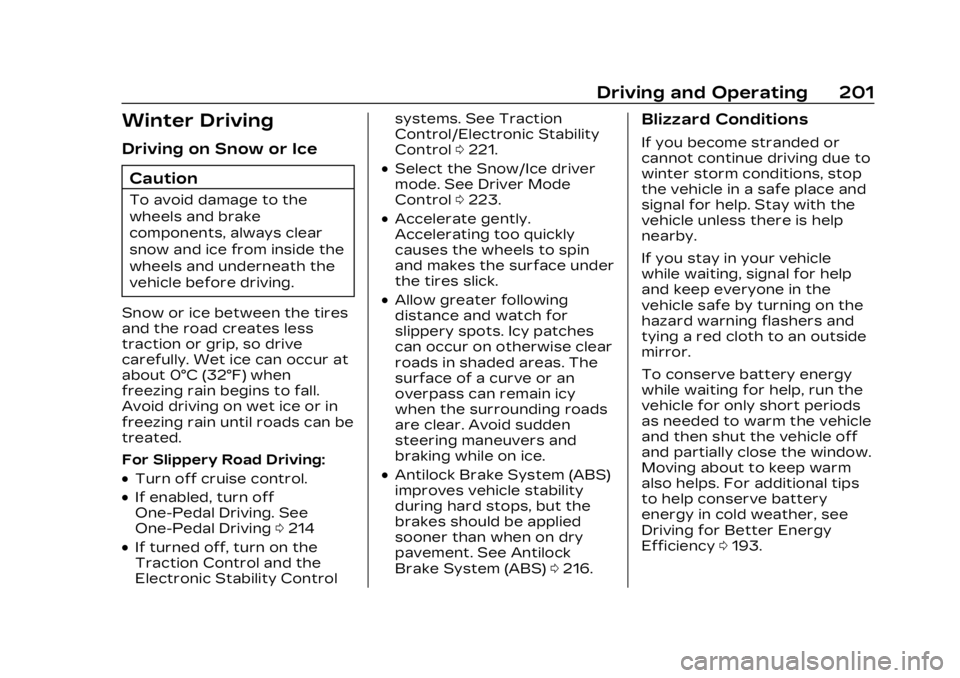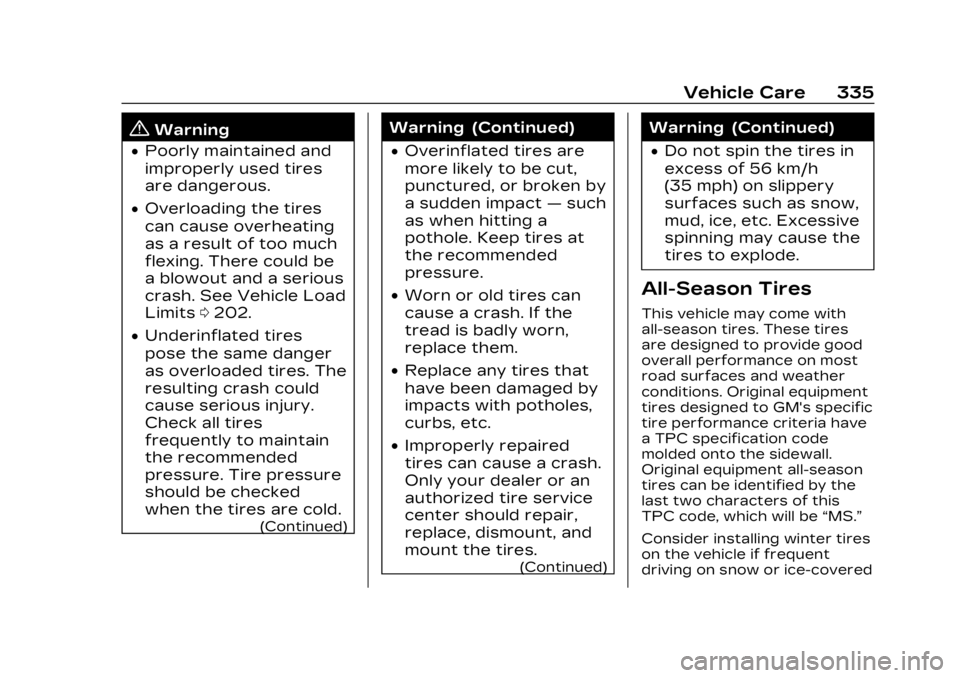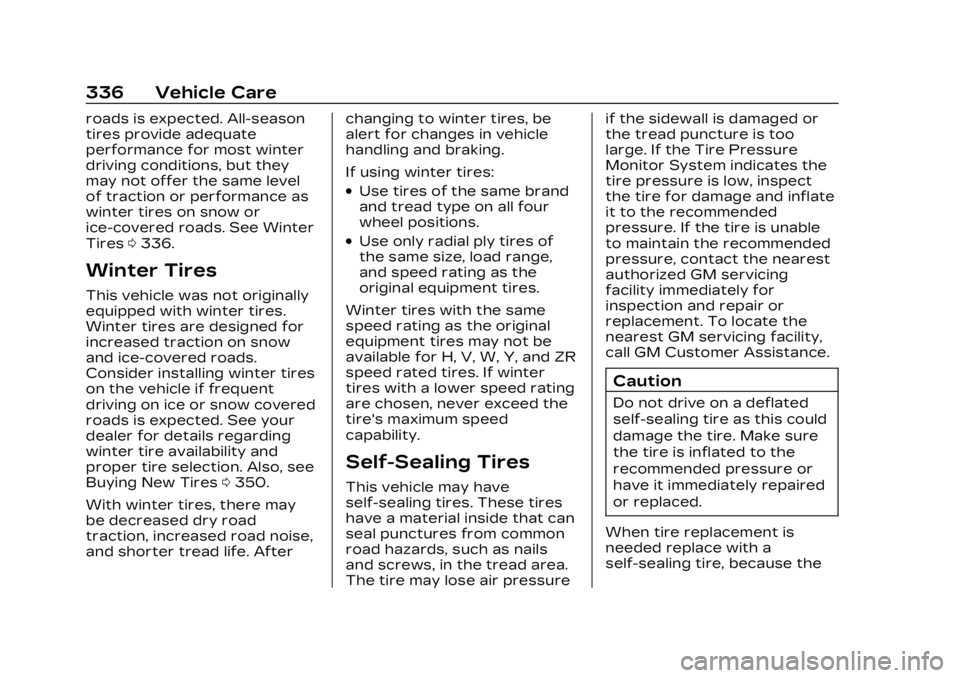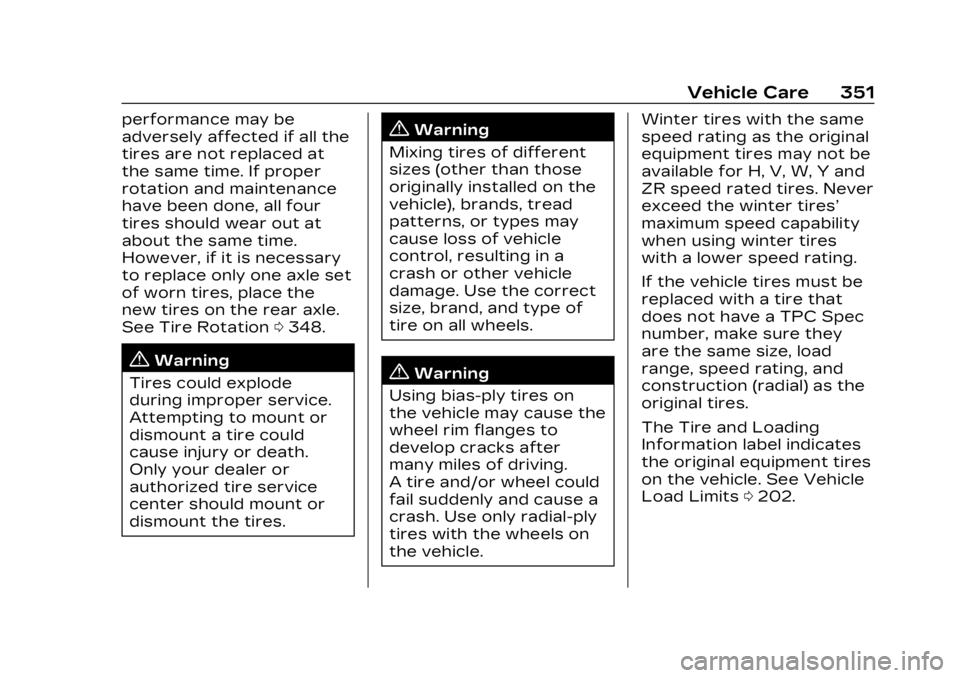2023 CADILLAC LYRIC winter tires
[x] Cancel search: winter tiresPage 202 of 424

Cadillac Lyriq Owner Manual (GMNA-Localizing-U.S./Canada-15644413) -
2023 - CRC - 2/23/22
Driving and Operating 201
Winter Driving
Driving on Snow or IceCaution
To avoid damage to the
wheels and brake
components, always clear
snow and ice from inside the
wheels and underneath the
vehicle before driving.
Snow or ice between the tires
and the road creates less
traction or grip, so drive
carefully. Wet ice can occur at
about 0°C (32°F) when
freezing rain begins to fall.
Avoid driving on wet ice or in
freezing rain until roads can be
treated.
For Slippery Road Driving:
.Turn off cruise control.
.If enabled, turn off
One-Pedal Driving. See
One-Pedal Driving 0214
.If turned off, turn on the
Traction Control and the
Electronic Stability Control systems. See Traction
Control/Electronic Stability
Control
0221.
.Select the Snow/Ice driver
mode. See Driver Mode
Control 0223.
.Accelerate gently.
Accelerating too quickly
causes the wheels to spin
and makes the surface under
the tires slick.
.Allow greater following
distance and watch for
slippery spots. Icy patches
can occur on otherwise clear
roads in shaded areas. The
surface of a curve or an
overpass can remain icy
when the surrounding roads
are clear. Avoid sudden
steering maneuvers and
braking while on ice.
.Antilock Brake System (ABS)
improves vehicle stability
during hard stops, but the
brakes should be applied
sooner than when on dry
pavement. See Antilock
Brake System (ABS) 0216.
Blizzard Conditions
If you become stranded or
cannot continue driving due to
winter storm conditions, stop
the vehicle in a safe place and
signal for help. Stay with the
vehicle unless there is help
nearby.
If you stay in your vehicle
while waiting, signal for help
and keep everyone in the
vehicle safe by turning on the
hazard warning flashers and
tying a red cloth to an outside
mirror.
To conserve battery energy
while waiting for help, run the
vehicle for only short periods
as needed to warm the vehicle
and then shut the vehicle off
and partially close the window.
Moving about to keep warm
also helps. For additional tips
to help conserve battery
energy in cold weather, see
Driving for Better Energy
Efficiency 0193.
Page 308 of 424

Cadillac Lyriq Owner Manual (GMNA-Localizing-U.S./Canada-15644413) -
2023 - CRC - 2/23/22
Vehicle Care 307
Vehicle Care
General Information
General Information . . . . . . 308
California PerchlorateMaterials
Requirements . . . . . . . . . . . . . 308
Accessories and Modifications . . . . . . . . . . . . . 308
Vehicle Checks
Doing Your OwnService Work . . . . . . . . . . . . . 309
Hood . . . . . . . . . . . . . . . . . . . . . . . . . . . 310
Underhood Compartment Overview . . . . . . . . . . . . . . . . . . . . 312
Cooling System . . . . . . . . . . . . . 313
Washer Fluid . . . . . . . . . . . . . . . . 314
Brakes . . . . . . . . . . . . . . . . . . . . . . . . . 315
Brake Fluid . . . . . . . . . . . . . . . . . . . 316
Battery - North America . . . . . . . . . . . . . . . . . . . . . . 317
Park Brake and P (Park) Mechanism Check . . . . . . . 320
Wiper Blade Replacement . . . . . . . . . . . . . . 320
Windshield Replacement . . . . . . . . . . . . . . . 321
Gas Strut(s) . . . . . . . . . . . . . . . . . . 321
Headlamp Aiming
Front Headlamp Aiming . . . . . . . . . . . . . . . . . . . . . . . 322
Bulb Replacement
Bulb Replacement . . . . . . . . . 323
LED Lighting . . . . . . . . . . . . . . . . 323
Electrical System
High Voltage Devices andWiring . . . . . . . . . . . . . . . . . . . . . . . 323
Electrical System Overload . . . . . . . . . . . . . . . . . . . . 323
Fuses and Circuit Breakers . . . . . . . . . . . . . . . . . . . . 325
Underhood Compartment Fuse Block . . . . . . . . . . . . . . . . . 326
Instrument Panel Fuse Block . . . . . . . . . . . . . . . . . . . . . . . . . 331
Wheels and Tires
Tires . . . . . . . . . . . . . . . . . . . . . . . . . . . 334
All-Season Tires . . . . . . . . . . . 335
Winter Tires . . . . . . . . . . . . . . . . 336
Self-Sealing Tires . . . . . . . . . 336
Low-Profile Tires . . . . . . . . . . 337
Tire Sidewall Labeling . . . . 337
Tire Designations . . . . . . . . . . 338
Tire Terminology andDefinitions . . . . . . . . . . . . . . . . . 339
Tire Pressure . . . . . . . . . . . . . . . 342 Tire Pressure Monitor
System . . . . . . . . . . . . . . . . . . . . . . 343
Tire Pressure Monitor Operation . . . . . . . . . . . . . . . . . . 344
Tire Inspection . . . . . . . . . . . . . 347
Tire Rotation . . . . . . . . . . . . . . . 348
When It Is Time for New
Tires . . . . . . . . . . . . . . . . . . . . . . . . . 349
Buying New Tires . . . . . . . . . 350
Different Size Tires and Wheels . . . . . . . . . . . . . . . . . . . . . . 352
Uniform Tire Quality Grading . . . . . . . . . . . . . . . . . . . . . 352
Wheel Alignment and Tire Balance . . . . . . . . . . . . . . . 354
Wheel Replacement . . . . . . 354
Tire Chains . . . . . . . . . . . . . . . . . . 355
If a Tire Goes Flat . . . . . . . . . 355
Jump Starting
Jump Starting - North America . . . . . . . . . . . . . . . . . . . . . 356
Towing the Vehicle
Transporting a DisabledVehicle . . . . . . . . . . . . . . . . . . . . . . 359
Recreational Vehicle Towing . . . . . . . . . . . . . . . . . . . . . . 362
Page 336 of 424

Cadillac Lyriq Owner Manual (GMNA-Localizing-U.S./Canada-15644413) -
2023 - CRC - 2/23/22
Vehicle Care 335
{Warning
.Poorly maintained and
improperly used tires
are dangerous.
.Overloading the tires
can cause overheating
as a result of too much
flexing. There could be
a blowout and a serious
crash. See Vehicle Load
Limits0202.
.Underinflated tires
pose the same danger
as overloaded tires. The
resulting crash could
cause serious injury.
Check all tires
frequently to maintain
the recommended
pressure. Tire pressure
should be checked
when the tires are cold.
(Continued)
Warning (Continued)
.Overinflated tires are
more likely to be cut,
punctured, or broken by
a sudden impact —such
as when hitting a
pothole. Keep tires at
the recommended
pressure.
.Worn or old tires can
cause a crash. If the
tread is badly worn,
replace them.
.Replace any tires that
have been damaged by
impacts with potholes,
curbs, etc.
.Improperly repaired
tires can cause a crash.
Only your dealer or an
authorized tire service
center should repair,
replace, dismount, and
mount the tires.
(Continued)
Warning (Continued)
.Do not spin the tires in
excess of 56 km/h
(35 mph) on slippery
surfaces such as snow,
mud, ice, etc. Excessive
spinning may cause the
tires to explode.
All-Season Tires
This vehicle may come with
all-season tires. These tires
are designed to provide good
overall performance on most
road surfaces and weather
conditions. Original equipment
tires designed to GM's specific
tire performance criteria have
a TPC specification code
molded onto the sidewall.
Original equipment all-season
tires can be identified by the
last two characters of this
TPC code, which will be “MS.”
Consider installing winter tires
on the vehicle if frequent
driving on snow or ice-covered
Page 337 of 424

Cadillac Lyriq Owner Manual (GMNA-Localizing-U.S./Canada-15644413) -
2023 - CRC - 2/23/22
336 Vehicle Care
roads is expected. All-season
tires provide adequate
performance for most winter
driving conditions, but they
may not offer the same level
of traction or performance as
winter tires on snow or
ice-covered roads. See Winter
Tires0336.
Winter Tires
This vehicle was not originally
equipped with winter tires.
Winter tires are designed for
increased traction on snow
and ice-covered roads.
Consider installing winter tires
on the vehicle if frequent
driving on ice or snow covered
roads is expected. See your
dealer for details regarding
winter tire availability and
proper tire selection. Also, see
Buying New Tires 0350.
With winter tires, there may
be decreased dry road
traction, increased road noise,
and shorter tread life. After changing to winter tires, be
alert for changes in vehicle
handling and braking.
If using winter tires:
.Use tires of the same brand
and tread type on all four
wheel positions.
.Use only radial ply tires of
the same size, load range,
and speed rating as the
original equipment tires.
Winter tires with the same
speed rating as the original
equipment tires may not be
available for H, V, W, Y, and ZR
speed rated tires. If winter
tires with a lower speed rating
are chosen, never exceed the
tire's maximum speed
capability.
Self-Sealing Tires
This vehicle may have
self-sealing tires. These tires
have a material inside that can
seal punctures from common
road hazards, such as nails
and screws, in the tread area.
The tire may lose air pressure if the sidewall is damaged or
the tread puncture is too
large. If the Tire Pressure
Monitor System indicates the
tire pressure is low, inspect
the tire for damage and inflate
it to the recommended
pressure. If the tire is unable
to maintain the recommended
pressure, contact the nearest
authorized GM servicing
facility immediately for
inspection and repair or
replacement. To locate the
nearest GM servicing facility,
call GM Customer Assistance.
Caution
Do not drive on a deflated
self-sealing tire as this could
damage the tire. Make sure
the tire is inflated to the
recommended pressure or
have it immediately repaired
or replaced.
When tire replacement is
needed replace with a
self-sealing tire, because the
Page 352 of 424

Cadillac Lyriq Owner Manual (GMNA-Localizing-U.S./Canada-15644413) -
2023 - CRC - 2/23/22
Vehicle Care 351
performance may be
adversely affected if all the
tires are not replaced at
the same time. If proper
rotation and maintenance
have been done, all four
tires should wear out at
about the same time.
However, if it is necessary
to replace only one axle set
of worn tires, place the
new tires on the rear axle.
See Tire Rotation0348.
{Warning
Tires could explode
during improper service.
Attempting to mount or
dismount a tire could
cause injury or death.
Only your dealer or
authorized tire service
center should mount or
dismount the tires.
{Warning
Mixing tires of different
sizes (other than those
originally installed on the
vehicle), brands, tread
patterns, or types may
cause loss of vehicle
control, resulting in a
crash or other vehicle
damage. Use the correct
size, brand, and type of
tire on all wheels.
{Warning
Using bias-ply tires on
the vehicle may cause the
wheel rim flanges to
develop cracks after
many miles of driving.
A tire and/or wheel could
fail suddenly and cause a
crash. Use only radial-ply
tires with the wheels on
the vehicle. Winter tires with the same
speed rating as the original
equipment tires may not be
available for H, V, W, Y and
ZR speed rated tires. Never
exceed the winter tires’
maximum speed capability
when using winter tires
with a lower speed rating.
If the vehicle tires must be
replaced with a tire that
does not have a TPC Spec
number, make sure they
are the same size, load
range, speed rating, and
construction (radial) as the
original tires.
The Tire and Loading
Information label indicates
the original equipment tires
on the vehicle. See Vehicle
Load Limits
0202.
Page 353 of 424

Cadillac Lyriq Owner Manual (GMNA-Localizing-U.S./Canada-15644413) -
2023 - CRC - 2/23/22
352 Vehicle Care
Different Size Tires
and Wheels
If wheels or tires are installed
that are a different size than
the original equipment wheels
and tires, vehicle performance,
including its braking, ride and
handling characteristics,
stability, and resistance to
rollover may be affected. If the
vehicle has electronic systems
such as antilock brakes,
rollover airbags, traction
control, electronic stability
control, or All-Wheel Drive, the
performance of these systems
can also be affected.
{Warning
If different sized wheels are
used, there may not be an
acceptable level of
performance and safety if
tires not recommended for
those wheels are selected.
This increases the chance of
a crash and serious injury.(Continued)
Warning (Continued)
Only use GM specific wheel
and tire systems developed
for the vehicle, and have
them properly installed by a
GM certified technician.
See Buying New Tires 0350
and Accessories and
Modifications 0308.
Uniform Tire Quality
Grading
The following information
relates to the system
developed by the United
States National Highway
Traffic Safety
Administration (NHTSA),
which grades tires by
treadwear, traction, and
temperature performance.
This applies only to
vehicles sold in the United
States. The grades are
molded on the sidewalls of
most passenger car tires. The Uniform Tire Quality
Grading (UTQG) system
does not apply to deep
tread, winter tires, compact
spare tires, tires with
nominal rim diameters of
10 to 12 inches
(25 to 30 cm), or to some
limited-production tires.
While the tires available on
General Motors passenger
cars and light trucks may
vary with respect to these
grades, they must also
conform to federal safety
requirements and
additional General Motors
Tire Performance Criteria
(TPC) standards.
Quality grades can be
found where applicable on
the tire sidewall between
tread shoulder and
maximum section width.
For example:
Page 356 of 424

Cadillac Lyriq Owner Manual (GMNA-Localizing-U.S./Canada-15644413) -
2023 - CRC - 2/23/22
Vehicle Care 355
Warning (Continued)
When replacing wheels, use
a new GM original
equipment wheel.
Caution
The wrong wheel can also
cause problems with bearing
life, brake cooling,
speedometer or odometer
calibration, headlamp aim,
bumper height, vehicle
ground clearance, and tire or
tire chain clearance to the
body and chassis.
Tire Chains
Caution
If the vehicle is equipped
with tire size 265/50R20,
use tire winter traction
devices only where legal and
only when necessary. Only
use textile traction devices,(Continued)
Caution (Continued)
such as tire snow socks,
that are the proper size for
the tires. Traction devices
must be installed only on the
tires of the drive axle. Drive
slowly and follow the
traction device
manufacturer’s instructions.
Driving too fast or spinning
the wheels can damage the
traction device.
If a Tire Goes Flat
It is unusual for a tire to blow
out while driving, especially if
the tires are maintained
properly. If air goes out of a
tire, it is much more likely to
leak out slowly. See Tires
0334 for additional
information. But if there ever
is a blowout, here are a few
tips about what to expect and
what to do:
If a front tire fails, the flat tire
creates a drag that pulls the
vehicle toward that side. Take your foot off the accelerator
pedal and grip the steering
wheel firmly. Steer to maintain
lane position, and then gently
brake to a stop, well off the
road, if possible.
A rear blowout, particularly on
a curve, acts much like a skid
and may require the same
correction as used in a skid.
Stop pressing the accelerator
pedal and steer to straighten
the vehicle. It may be very
bumpy and noisy. Gently brake
to a stop, well off the road,
if possible.
The vehicle has no spare tire,
no tire changing equipment,
and no place to store a tire.
If the vehicle has self-sealing
tires, see Self-Sealing Tires
0
336. Tread punctures
typically will not cause tires to
lose air. However, if the vehicle
does get a flat tire, there is no
spare tire, tire changing
equipment, or place to store a
tire. Contact Roadside Service
0 388 for help.
Page 391 of 424

Cadillac Lyriq Owner Manual (GMNA-Localizing-U.S./Canada-15644413) -
2023 - CRC - 3/2/22
390 Customer Information
necessary Cadillac parts and
tools required to handle most
roadside repairs.
Services Not Included in
Roadside Service
.Impound towing caused by
violation of any laws
.Legal fines
.Mounting, dismounting,
or changing of snow tires,
chains, or other traction
devices
Service is not provided if a
vehicle is in an area that is not
accessible to the service
vehicle or is not a regularly
traveled or maintained public
road, which includes ice and
winter roads. Off-road use is
not covered.
Services Specific to
Canadian-Purchased
Vehicles
.Lock-Out Service: Vehicle
registration is required.
.Trip Interruption Benefits
and Service:
Pre-authorization, original
detailed receipts, and a copy
of the repair orders are
required. Once authorization
has been received, the
Roadside Service advisor will
help you make arrangements
and explain how to receive
payment. Items considered
are hotel, meals, and rental
car or a vehicle being
delivered back to the
customer, up to 800 km.
.Alternative Service: If
assistance cannot be
provided right away, the
Roadside Service advisor
may give you permission to
get local emergency road
service. You will receive
payment, up to $100, after
sending the original receipt
to Roadside Service.
Mechanical failures may be
covered, however any cost
for parts and labor for repairs not covered by the
warranty are the owner
responsibility.
Scheduling Service
Appointments
When the vehicle requires
warranty service, contact your
dealer and request an
appointment. By scheduling a
service appointment and
advising the service
consultant of your
transportation needs, your
dealer can help minimize your
inconvenience.
If the vehicle cannot be
scheduled into the service
department immediately, keep
driving it until it can be
scheduled for service, unless,
of course, the problem is
safety related. If it is, please
call your dealership, let them
know this, and ask for
instructions.
If your dealer requests you to
bring the vehicle for service,
you are urged to do so as